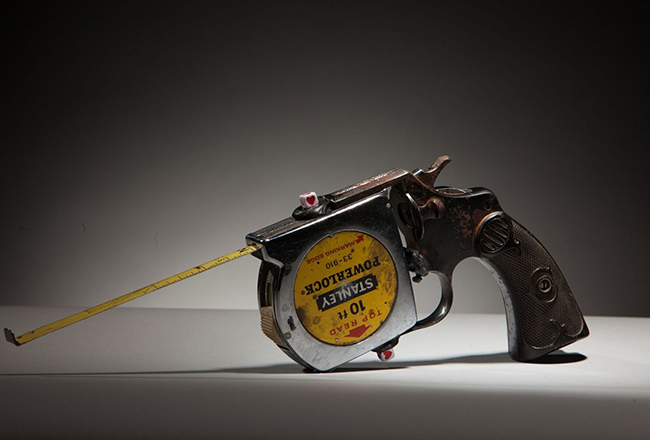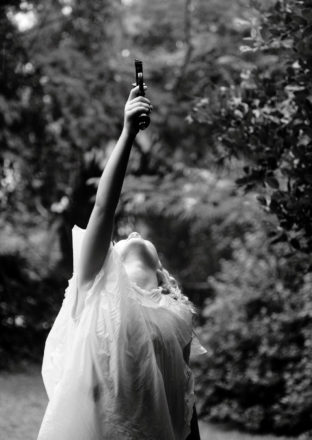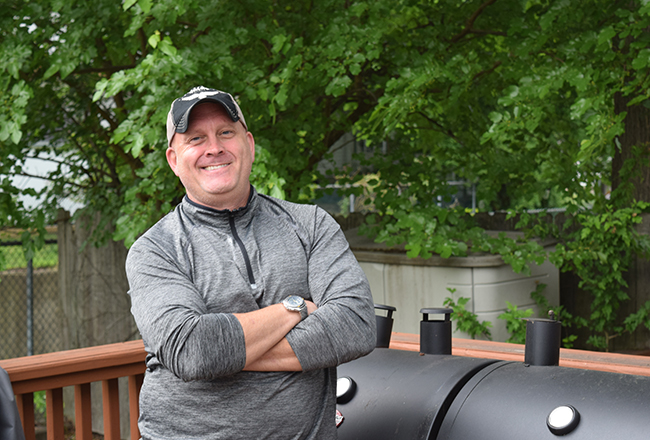
Upon entering the exhibit “#UNLOAD: Guns in the Hands of Artists” at the Fairfield University Art Museum, the visitor is confronted with a large glass case packed with disassembled guns. Within the exhibit, the gun culture is presented in a mix of surreal and provocative imagery: a toy – dispensing machine features bullets within plastic eggs, a decommissioned gun has its barrel replaced with a tape measure, a rifle is submerged in Excalibur-style into a large stone.
“#UNLOAD” was first staged in the mid-1990s at Positive Space in New Orleans, in response to a rise in the local murder rate. Artist Brian Borrello and gallery owner Jonathan Ferrara curated the exhibition, which gained national attention. In 2014, Ferrara reorganized the exhibition to include international artists, and it has been displayed across the country in galleries, universities and the rotunda of the Russell Senate Office Building. However, the Fairfield University Art Museum marks the first time it has been presented in a museum setting.

“I”™m very proud that our museum is the first to take it,” said Carey Mack Weber, assistant director for the museum. “It”™s a controversial subject, but statistics show more than 80 percent of Americans feel we have a problem with gun violence.”
The exhibit, which opened June 1, follows the museum”™s attendance-breaking “The Holy Name ”” Art of the Gesù: Bernini and his Age,” which ran Feb. 2 to May 19 and offered a collection of artistic masterpieces from the Church of the Gesù, the Roman mother church of the Society of Jesus. “We had 8,000 at ”˜Art of the Gesù,” said Weber. “That was enormous for us. We had people come from Europe and all over the United States. Generally, we get 5,000 people a year.”
The back-to-back exhibits could be seen as a new peak for the museum, which had its accidental creation in the late 1990s when Bridgeport”™s Museum of Art, Science and Industry was transitioning into the Discovery Museum and gifted its collection of Italian Renaissance artwork to Fairfield University. “Once we got them, we had no place to put them,” Weber said. “We kept them in a locked room in the library and people had to make an appointment to see them.”
At first, the museum got off to a rocky start. It was originally called the Bellarmine Museum of Art, named after the Bellarmine Hall building on the university campus that housed its collection. Weber admitted the original name created some confusion. “We feel people are still having trouble figuring out who we are and what we do,” she said.
The museum later absorbed the Walsh Gallery, which existed within the Quick Center for the Arts on the university campus since 1985. This created a new dilemma, as the Quick Center is a considerable walking distance from Bellarmine Hall. Weber acknowledged that it was not the ideal setup, but there are no plans to create a new structure accommodating both exhibition spaces.
“It”™s confusing and it”™s not particularly convenient, but it is a reality,” she said. “We are trying to have people understand that, so they can plan their visit.”
Weber pointed out that the museum has a faculty liaison attached to each exhibition and it seeks to use art for educational enrichment.
“We are a teaching museum ”” not just for the university, but for the community,” she said. “And while we have a small collection, we try and have our exhibitions cover the entire history of art.”
Indeed, the museum has covered global artistic experience with a focus on subjects that rarely find a spotlight in Connecticut”™s museum scene. Recent exhibitions offered insight into the drawings of the Plains Indians of North America, the majesty of Byzantine sacred art and the haunting Vietnam photographs of Craig J. Barber, an ex-combat Marine. While “#UNLOAD” is in the Walsh Gallery, the Bellarmine galleries offers a presentation of modern designs for the mizusashi, a water jar used in the Japanese tea ceremony.
Exhibition planning usually takes two to three years of advance work, though Weber said the museum was able to tweak the Walsh Gallery calendar on relatively tight notice to accommodate the “#UNLOAD” exhibition for its run through Oct. 13. Three panel discussions were coordinated to run with the exhibition, and the Quick Center commissioned Movement Art Is to create a special dance presentation related to “#UNLOAD” that will premiere on Oct. 12.
Looking ahead, Weber noted that upcoming exhibitions will highlight the masks and statues of early 20th century Liberia, celebrate American art deco icon Hildreth Meière, offer a somber consideration of the fate of Jewish children in France during the Holocaust years, and present a colorful overview of contemporary Cuban art.
“There is nothing like being physically next to an object, as opposed to seeing a slide or a digital image,” Weber said. “And everything we do is free. It”™s a resource that a lot of people aren”™t aware of.”






















